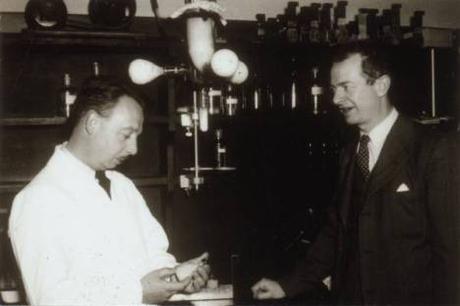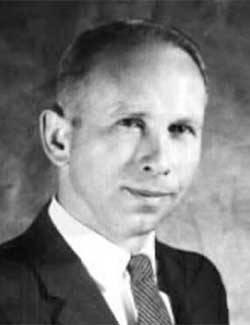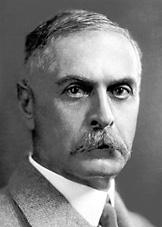
Dan Campbell and Linus Pauling in a Caltech laboratory, 1943.
[Part 3 of 6 in a series investigating Pauling’s work on the serological properties of simple substances.]
In April 1943, only four months after releasing his first four papers on the serological properties of simple substances, Linus Pauling was ready to publish more. His fifth paper in the series reported out on the results of hapten inhibition experiments that his lab had conducted using two different antibodies. In the experiments, “measurements were made of the inhibitory effect of each of twenty-six haptens on one antigen-antibody reaction, and interpreted to give values of the bond-strength constant of the haptens with the antibody.”
The results of the experiments, with particular attention paid to the twenty-six hapten molecules, were then discussed in the context of their possible molecular structure. In this discussion, Pauling pointed out that some of the polyhaptenic molecules did not produce participates, a detail that was explained as having been caused by steric hindrance, or the inability for a reaction to take place due to molecular structure.
David Pressman was again a co-author of the paper, as were two graduate students, John T. Maynard and Allan L. Grossberg. Grossberg would stay with Pauling’s lab until 1946 – two years after completing his war-time master’s degree – and was involved with three more papers from the series. He later went on to work with Pressman at the Roswell Park Memorial Institute and eventually became associate chief of cancer research there.
Pauling’s immunological work was quickly producing exciting new results, momentum that was recognized by The Rockefeller Foundation, which awarded Pauling another grant in June 1943. Pauling also began delivering lectures on his serological research, notably including the Julius Stieglitz Memorial Lecture in January 1944.
Articles six, seven, and eight of the serological series were each published a few months apart from one another, beginning in March 1944. Pauling co-authored these papers with previous collaborators Pressman, Campbell and Grossberg, and also with Stanley Swingle, a research fellow and instructor who had earned his Ph.D. at Caltech in 1942.
Paper VI put forth more evidence for the Marrack-Heidelberger framework theory, for which Pauling had first announced his support in Paper I. The experiments specified in Paper VI made use of fifty different substances possessing either one, two, or three haptenic groups. The results of these trials indicated that a substance containing two different haptenic groups would only form a precipitate when antisera binding to both of those two groups were present. Of this finding the article states, “this provides proof of the effective bivalence of the dihaptenic precipitating antigen, and thus furnishes further evidence for the framework theory of antigen-antibody precipitation.”
In the seventh paper, published in May 1944, Pauling returned to the simple theory for calculating the inhibition of precipitation that he had developed in Paper II, published at the end of 1942. In his discussion, Pauling reported that his laboratory’s experiments found general qualitative agreement with the theory, but the numbers tended to be off. In seeking a more reliable equation, Pauling worked to improve the theory, accounting now for the fact that a single antiserum can contain slightly different antibody molecules with assorted combining powers.
This new and improved theory, and the equation that accompanied it, agreed with experimental results much better than had the original proposal. Indeed, by accounting for variations in the antibodies, Pauling and his colleagues had succeeded in developing a “quantitative theory of the inhibition by haptens,” which would prove important to much of the work that was to come.
Paper VIII, “The Reactions of Antiserum Homologous to the p-Azobenzoic Acid Group,” appeared in October 1944 and shared the results of experiments done with a new type of antibody. Previously, experiments had been conducted with antisera homologous to two different acid groups. However, in these new investigations, the Caltech researchers used antisera homologous to another type of acid group. In doing so, Pauling and his colleagues were attempting to gauge optimum acidity levels for serological reactions; to identify the types of antigens that most readily cause precipitation; to likewise identify haptens that inhibit precipitation; and to measure the strength of their inhibiting power.
Despite Pauling’s extensive involvement in studying reactions of antibodies and antigens, he still had time for other research interests. In February 1945, Pauling and Campbell announced that they had created a usable substitute for blood plasma, the result of three years of work supported by military contracts. Shortly thereafter, Pauling learned a few key details about sickle cell anemia while meeting with the other members of the Medical Advisory Committee. He immediately thought that hemoglobin was involved and went on to experimentally prove that the disease located its source on the molecular level; a first in the history of science.

Arthur Pardee, 1980
June, July, and September of 1945 each saw the publication of another serological article: Papers IX, X, and XI respectively. The final two of this set featured the addition of a pair of new collaborators. John Bryden, a co-author for Paper X, completed his master’s degree around the time that the article was published, and Arthur Pardee was in the middle of his doctoral program when he worked on Paper XI. Pardee also worked on the experiments described in Paper XIV, although the article was published after he had completed his Ph.D. and returned to Berkeley. Pardee later went on to enjoy a hugely successful career as the Chief of the Division of Cell Growth and Regulation of the Dana Farber Cancer Institute at Harvard Medical School.

Karl Landsteiner
Papers IX and X shared the results of still more inhibition experiments. The experiments reported on in Paper IX largely confirmed Karl Landsteiner’s discovery on the combining of antiserum and antigen, or antiserum and hapten. Landsteiner had found that less bonding occurred between antibody and antigen or antibody and hapten if the substituent groups on the binding molecule were different from the antigen that created the antibody. The Pauling group confirmed this theory and, in addition, described the forces that affect hapten inhibition. Pauling believed that it had to do with intermolecular forces “including electronic van der Waals attraction…the formation of hydrogen bonds, and steric hindrance,” a supposition that would play a crucial role in later papers in which Pauling explained the incredible specificity that governs the behavior of these molecules.
Paper X studied the effect of molecular asymmetry on serological reactions. In this series of experiments, Pauling and two collaborators, David Pressman and John Bryden, had prepared an antiserum with an optically inactive immunizing antigen; e.g., a molecule that does not rotate plane polarized light. However, even though the immunizing antigen was not optically active, the antibodies in the serum combined more strongly with one configuration over an optically active hapten, which does rotate light, than in the other configuration. Pauling and his colleagues hypothesized that this was due to the presence of optically active amino acid residues in the antibody molecules.
Paper XI, published in September 1945, discussed reactions of antisera with various antigen substitutes. In this instance, the Pasadena group measured the precipitate formed by these reactions to gauge the inhibiting power of the haptens. They then correlated hapten-inhibiting power to molecular structure, suggesting that if a substance mixed with antisera more readily, then the structure of the molecule might be smaller. They ultimately discovered that if a hapten structure matched an immunizing azoprotein structure, the haptenic group exhibited a strong inhibitory effect.
In February 1946, Pauling and co-authors Pressman, Grossberg, and Leland Pence published the twelfth serological article. This was Grossberg’s fourth and final contribution; ultimately, he served as co-author on more of the series than did any other collaborator, save David Pressman and Dan Campbell. New to the series was Leland Pence, an assistant professor of organic chemistry at Reed College who had been collaborating with Pauling since 1942.
Prior to Paper XII, all previous experiments carried out by the lab had used negatively charged or neutral compounds. Paper XII presented the results of experiments that used a positively charged antibody. Pauling and his collaborators found that, even when using positively charged antibodies, hapten inhibition occurred the same way, with the same factors, as was the case with a negative or neutral compound. That said, one important difference that was observed was the ideal acidity for maximizing precipitates; when using a positively charged antibody, the pH required for the optimum amount of precipitate was much lower.
Advertisements